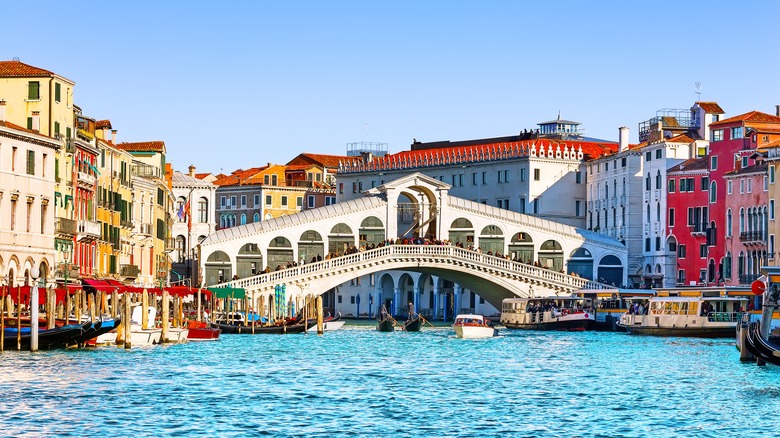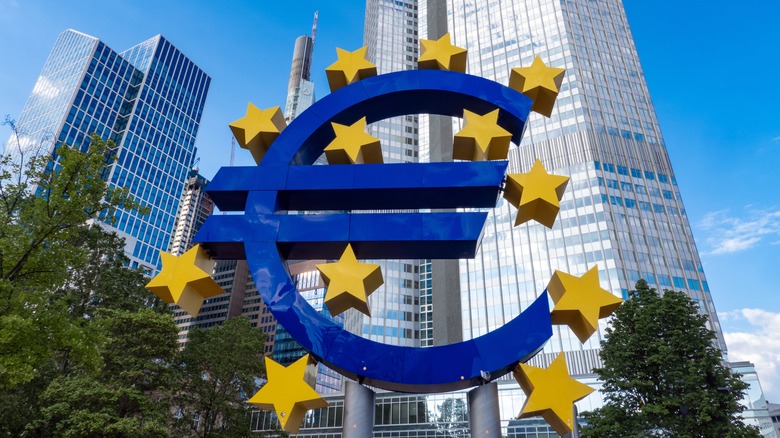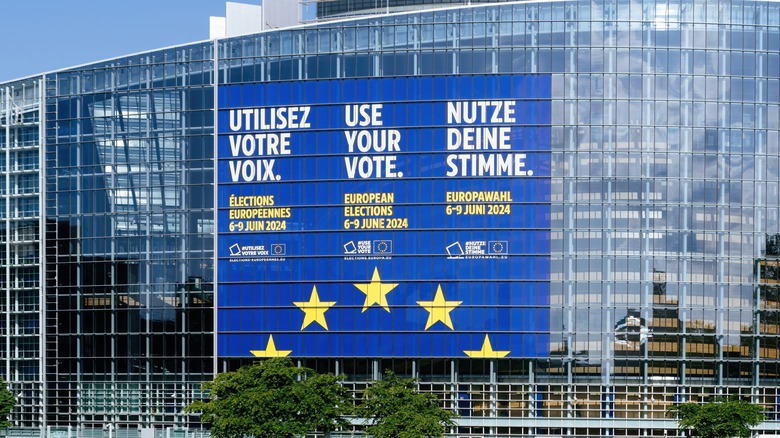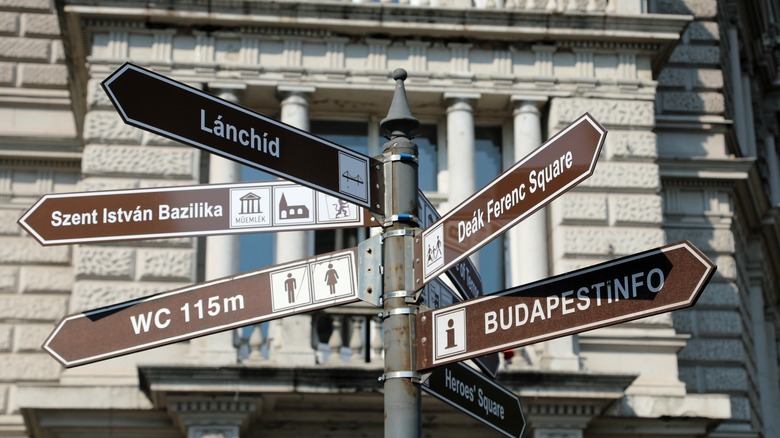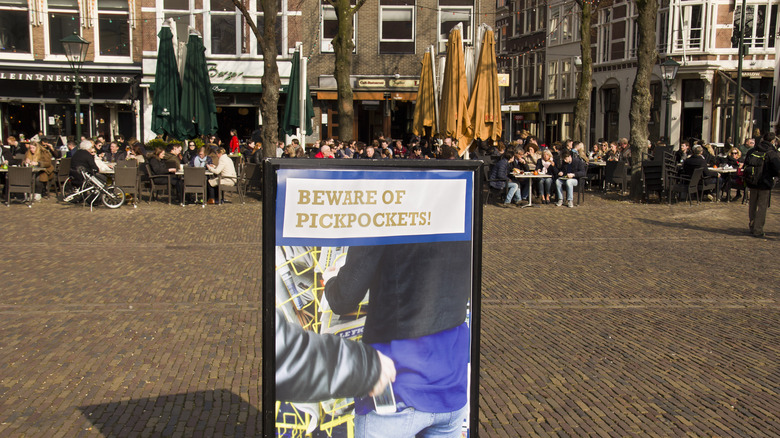An Easy-To-Digest Guide On Planning Your First Trip To Europe
It's a big world out there, but for many of us, a once-in-a-lifetime vacation destination that we can't miss is Europe. A continent known for its history, culture, food, and great outdoors, Europe is rich and varied. There's a lot to see here, from iconic structures like the Eiffel Tower, to towering mountains such as the Alps, to beaches that will make the heart melt. A traveler going to the continent for the first time might struggle to identify exactly where and what to visit, how to get around, and what phrases to learn. All of these variables can be daunting.
Luckily we've got answers for you. Islands exclusively spoke with Victoria Fricke, owner of the luxury travel agency Vic's Vacations, to get the low-down on what to consider when planning your very first trip to Europe. You can certainly organize your inaugural trip to the continent yourself, but planning the adventure in tandem with a professional can pay dividends. "Using a travel agent allows you to remove the stress of identifying the right location, amount of time in that destination, how to get from point A to point B," explains Fricke. "Vic's Vacations specializes in European travel and we do the heavy lifting for you. Simply let us know the type of trip you wish to take, the overall experience you're looking for and the price point you feel comfortable with, and we'll curate an itinerary just for you!"
Work out a budget
Travel to Europe isn't cheap, and while some countries are more affordable than others, the costs all add up. "You have to budget for the trip you want to experience," notes Fricke. "Certainly you can do a trip to Europe for $5,000, but you're staying in hostels and Airbnb properties. You're not staying in hotels with the amenities, walking proximity where you want to go and overall expectations you're probably used to." Clearly identifying a budget will probably be the single most important thing that dictates the shape of your trip. You'll have to factor in travel costs within the continent, expenses for a place to stay throughout the trip, and airfare to get you there.
"This is where you use your credit card points," suggests Fricke. "Flights to Europe are expensive. Rather than pay $1000-$1800 per person, save credit card points and use those!" Finally, on the budget, you'll need to add in expenditure for food, attractions, souvenirs, and special treats (like maybe a helicopter ride around Barcelona), and the numbers really start to climb. Knowing how much you can spend will dictate how long you can go for (how much vacation time you can take off will also be a factor, of course), the kind of place where you can stay, and what you can do there. Without knowing any of that, how will you plan the trip?
Check your clearance documents
The majority of European countries are within a grouping known as the Schengen area. What this means, in practical terms for a traveler, is that there aren't really formal borders between them. Once you enter one of them, you can travel to another without any kind of immigration control. It's hugely convenient if you plan to flit between nations in the zone, as it enables travel to be efficient, and seamless. What you will need is a passport that is valid for six months past the first day of your trip. If you get to the airport to check-in for your flight to Europe, and your passport has less than that before it expires, you might be denied boarding. Check your passport well before you start planning your trip to ensure that you won't need to renew it.
These are the rules as they currently stand, but from the middle of 2025, they are expected to change, with the introduction of visa-style admission. That's when Americans, as well as citizens of more than 50 other countries, will need an ETIAS to visit 30 countries in Europe. Also in the same year, the United Kingdom, which is not part of the Schengen area, plans to roll out its ETA scheme that will apply to U.S. citizens. Both the ETA and ETIAS will require the filing of an online application.
Don't expect to see all of Europe in one go
Europe is a big place, with more than 45 countries. While it might seem like a nice idea in theory, in reality you aren't going to be able to "do" Europe in a one- or two-week trip. You might want to see the Colosseum in Rome, the Acropolis in Athens (a place best visited in the evening), and Buckingham Palace in London, but visiting them all takes time, lots of effort, and money. "When people send in their inquiries preparing to plan a trip to Europe typically they come with every European city they have on their bucket list," explains Fricke. "It's imperative to be realistic about what a trip to Europe over a 10-day trip can fit in."
While certain places might stand out, like globally-renowned sites whose pictures fill tourism brochures, and Instagram feeds, they don't have to be the only option. "Make the memories you want to, not the ones social media says you should," advised Fricke. "If you don't want to see the Mona Lisa, don't go to get a photo with it. Many tourist experiences are overly crowded and the experience is far less magical than the photos people post portray." And, it's just as important to plan on down time, like hanging out for an afternoon in a cafe or park. These might just prove to be some of your best moments on the trip.
Expect jet lag
Jet lag can wreak havoc on you physically and mentally. You can feel fatigued and unmotivated for days, irritable for no apparent reason (hint, it's the jet lag), and have your digestive system thrown out of whack while you adjust to the new time zone. Flying to Europe, you will contend with a time difference of a minimum of four hours from the U.S. (Iceland is four hours ahead of the East Coast during Daylight Saving Time, five hours ahead the rest the year). That number only increases if you fly further east, or from a different time zone in the United States. Your body will need to adjust, and by some measures, it takes one day or more for every time zone that you have changed. For a 10-day trip to Europe, for instance, you might spend half of the journey trying to reset your internal clock, and that is no fun.
While there is no pill to cure jet lag, you can take steps to minimize it. Try to adjust to the time zone of your destination as soon as you can. Some people even do this a few days before the trip, but not everyone has that luxury. Once you board the flight, adjust your watch or clock to the time at your destination. If it's night there, sleep, if it's daytime, stay awake. And, when you arrive in Europe, don't pack in too much on your first day or two .
Learn some basic lingo
A few phrases, wherever you go, will come in handy, like these ones in Spanish before a trip to Spain. Not only will they help you to communicate with locals, even if just on a basic level, they also show that you recognize and appreciate the culture of the place that you are visiting. That kind of respect can go a long way toward making you feel welcome. It's also just plain fun to learn to say things in another language, a good exercise for the brain, and a cool party trick to have up your sleeve.
Since Europe is, as we've already mentioned, a large continent, we won't list any phrases in any particular language as they won't be of use in every country. Instead, we'll identify some general words and phrases that you can learn ahead of time in the language used in the country that you'll be visiting. "Hello," "goodbye," and greetings like, "good morning" and "good night," are all useful to have in your armory. Of course, if you interact with any people, "please" and "thank you" are indispensable. For shoppers or diners, "How much does this cost?" and "Can I have the bill?" are crucial phrases. And, as you are unlikely to get fluent in the local tongue during your trip, "Do you speak English?" is always worth having ready at a moment's notice.
Don't rent a car
Driving at home, in the area where you live, can sometimes feel so effortless that you can't even remember certain turns, or stops, or maneuvers. But, take yourself out of a location where everything is familiar, and suddenly driving can be extremely stressful. If you drive in Europe, you'll have to parse signs that appear in another language and learn rules that you likely don't understand. You might also need to purchase an International Driving Permit, and while they aren't expensive (around $20), it's just another thing to organize before the trip.
Public transport is often very good in Europe, especially in the cities. In fact, in one underrated European country, the public transport is actually free. There's also a huge range of budget airlines operating across the continent, with some that might already be familiar to American travelers. These include EasyJet and Ryanair, both of which have hubs in London, Wizz Air (headquartered in Budapest), and carriers like Vueling, Transavia, and Condor among the options.
Pack light
If you do end up flying on one of these low-cost airlines between cities and countries, note that their baggage policies can be strict. You might have checked in a large suitcase on the flight from America to Europe, but that same suitcase might cost more to check in on a European budget flight, if it's even allowed. Ryanair, for instance, has a top limit of 20kg (about 44lbs) for its check-in luggage, and any weight above that will be charged excess, which is pricey.
"Many unsuspecting travelers pay hefty overweight bag fees for both the size and weight of their luggage," warns Fricke. "So pack for your hopper flight, not the overseas flight." Fricke also suggests leaving any fancy shoes or high heels at home. "Pack comfortable walking shoes and sandals. You'll be on your feet most of the day exploring and a blister is a surefire way to ruin a trip."
Shoppers prepare to spend
If designer labels are your jam, then you might be in for a treat. For some luxury goods made in Europe, prices are substantially cheaper. The price of an item in Europe is calculated with VAT, or Value Added Tax, a form of sales tax that is common throughout the continent. Local residents can't really do anything about this, but travelers that live outside the European Union (EU) can claim that portion of the price back before they leave the EU.
You'll need to have the right paperwork in order in order to get this cut on the price. This includes a refund document form, and receipts that show the VAT charged. "Luxury goods such as Louis Vuitton, Chanel, Fendi and more are often going to have a lower cost in Europe and you'll get your taxes refunded to you prior to leaving the country often making them 10-30% cheaper to buy in Europe vs the US," declares Fricke.
Be realistic in your hotel expectations
Some of the hotels in Europe have been around for centuries, and you might think that this shows when you see their interiors. They might not have air-conditioning or double-paned windows, and many have smaller rooms, but they do promise lots of charm. It's important to understand that distinction. Fricke explains, "The charm and history of Europe along with its slow pace is what makes it such a romantic and wonderful trip. Don't expect modern and sleek accommodations in most destinations, as the charm really is the history of the hotel."
And when we mean old, sometimes we mean really old. Take the Olde Bell, located a little west of London. It was originally built in the 1100s to house guests that were visiting the nearby monastery. Rooms are tasteful, but might have low ceilings, or wood beams visible in them. That's not to say there aren't modern hotels with a sense of contemporary sleekness about them, but they aren't everywhere. And since room inventory can get tight, especially in popular cities and destinations during peak season, you should book lodging well in advance.
Pick the season that's best for you
Much like trips anywhere in the U.S. and nearby, there are times when travel is ideal, and others when it is questionable. The Caribbean and parts of America, for instance, are prone to the effects of hurricane season, though there are islands in the Caribbean where you can have a stress-free vacation without fear of these deadly winds. "Consider the weather and your experience. If you want to have a Christmas Market experience or winter in Paris, go for it," reasons Fricke. "Keep in mind the full scope of the trip — how much walking you'll do, exploring and sightseeing outside. If the idea of being bundled up makes you cringe, consider a trip during the spring or early fall to avoid crowds. Summer is the most expensive time to travel and of course the most popular."
Yes, you'll have to battle the crowds during peak season in Lyon, or London, or Lisbon, but you'll also be able to walk around in shorts and T-shirts and enjoy the sensation of an ice cream cooling your palate. In winter, you might feel like you have the destination to yourself, and in the case of coastal vacation spots, that might be true. Many of these effectively close for the winter, since there's little business. But that season also presents opportunities — it's a time of year when airfares to Europe are cheaper. It's also the best time for skiers.
Understand the money rules
Even though we live in an increasingly cashless society, carrying cash is still important in Europe for paying things such as road tolls. But that's not the only benefit of having some on hand. "Bathrooms aren't free or for general public use like they are in the US," Fricke explains. "Always carry a few Euros to pay for public bathrooms or be prepared to buy a coffee to use one inside a cafe." Fricke recommends downloading the Flush app, which will help you to locate public restrooms.
If you are in a restaurant, there are also a couple of other points that you need to consider. In the US, tipping 20% is commonplace, but in Europe, a much lower rate is acceptable. "A 5-10% is much more customary," notes Fricke. And free tap water, which seems like a right in restaurants across the US, is not always available in Europe, as Fricke points out. "You pay for bottled water everywhere you go. It's often more expensive than the wine you drink, too!"
Watch your belongings
Unfortunately, while you go wandering around Europe, taking in the sights, sounds, and tastes of the continent, pickpockets are eyeing up your belongings. This is especially true at popular tourist spots, like Rome's Trevi Fountain, the Eiffel Tower in Paris, and the pedestrianized shopping thoroughfare of Las Ramblas in Barcelona. It's important that you really keep track of all your items, including your bag, backpack, shopping bags, and phone. And not just when you're walking around in a crowded public place, but also when you're seated at a cafe (both indoors and outdoors), buying something in a store, or looking at a map for directions.
Fricke points out that zip ties are a cheap, and effective way to help keep your belongings safe. "A zip tie can secure the clasp of your fanny pack. Just be aware of your phone on tables and how easy to access your personal belongings are to someone with bad intentions. Don't travel scared, just be aware." You can also use these 10 hacks that will protect you from pickpockets while you travel.
Come prepared
Some cards charge as much as 3% on every foreign transaction as a fee, so if you charge $4,000 in Europe, you'll end up handing over $120 in fees. Seems pointless, after all you could get a full-day tour of Venice for about that amount. You'll probably charge many expenses to your credit card, so try to use one that doesn't come loaded with fees for overseas transactions, because these add up quickly.
Downloading some apps will also make your life easier, such as Omio (for travel booking), AZair (good for sourcing low-cost airfare), and maps.me (a mapping interface). Fricke also recommends train apps like the one for Trenitalia if you'll use trains. You can also plot your route for the day on Google Maps, and use the app Bounce if you need to store luggage. For taxis, Freenow is a useful app, used in 9 countries across Europe. "It's typically cheaper than a taxi on the street and works similar to Uber," reveals Fricke.
Finally, the electrical current and plug sockets in Europe are different from the United States. The voltage runs at about 220-240V, so it will fry your electrical components if you aren't careful, (often laptop chargers and phone cables can handle dual voltage). Plug shapes are different from country to country, so you'll need the relevant adapter. "Consider getting one that can be used in different countries if you have plans to travel to Europe again!" Fricke advises.
